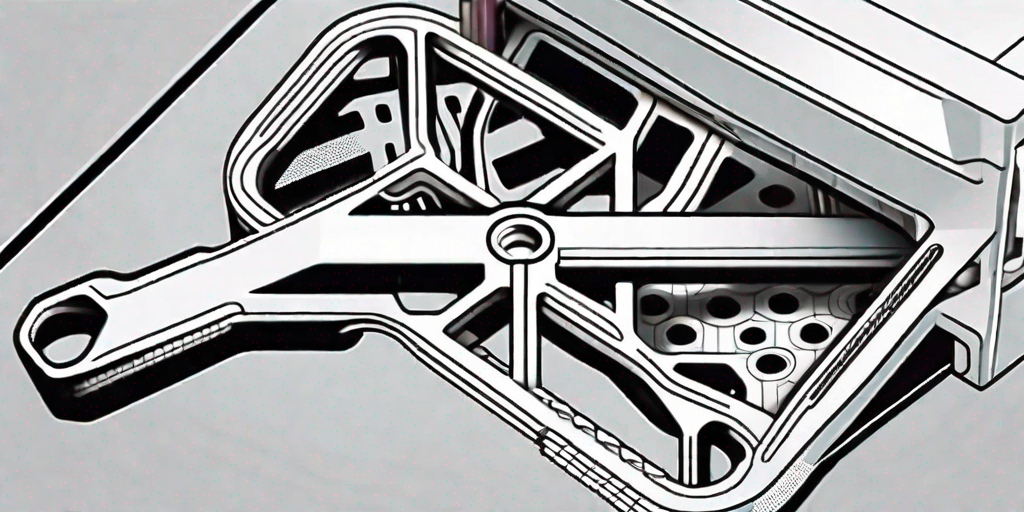Understanding 3D Printing with an Innovation Keynote Speaker's Help

Understanding 3D Printing with an Innovation Keynote Speaker's Help
In recent years, 3D printing has emerged as one of the most revolutionary technologies, disrupting various industries and transforming the way we manufacture and design objects. However, for many, the concepts and inner workings of 3D printing may still seem elusive and complex. That's where an innovation keynote speaker can make a significant impact. By breaking down this intricate technology into understandable pieces, they shine a light on the exciting world of 3D printing and simplify even the most complex concepts.
Understanding the Basics of 3D Printing
Before delving into the role of an innovation keynote speaker in explaining 3D printing technology, it's crucial to grasp the fundamentals of this groundbreaking innovation. At its core, 3D printing, also known as additive manufacturing, involves creating three-dimensional objects layer by layer using computer-aided design (CAD) files. This process eliminates the need for traditional manufacturing techniques, such as molding or subtractive manufacturing.
The key to comprehending 3D printing lies in understanding its primary components: the 3D printer, the material, and the design software. Imagine the 3D printer as a sophisticated robotic arm that meticulously follows the instructions provided by the CAD file. The material used can range from plastics and metals to ceramics and even biological matter. Finally, the design software translates the digital model into instructions that the printer can execute.
When it comes to the 3D printer itself, there are various types available, each with its own unique capabilities. For instance, some printers use a process called fused deposition modeling (FDM), where a plastic filament is heated and extruded through a nozzle to create the object layer by layer. Other printers utilize stereolithography (SLA), which involves using a liquid resin that is cured by a laser to solidify each layer.
Materials used in 3D printing have also evolved significantly over the years. Initially, plastics were the primary choice due to their affordability and versatility. However, advancements in technology have paved the way for the use of metals, such as titanium and aluminum, allowing for the creation of durable and functional parts. Additionally, ceramics have found their place in 3D printing, enabling the production of intricate and heat-resistant objects.
Design software plays a crucial role in the 3D printing process, as it is responsible for translating a digital model into instructions that the printer can understand. There are numerous software options available, ranging from beginner-friendly programs to advanced tools used by professional designers and engineers. These software packages allow users to create, modify, and optimize their designs before sending them to the printer.
By unraveling these basic principles, an innovation keynote speaker equips audiences with the necessary foundation to navigate the expansive world of 3D printing. Understanding the components of a 3D printer, the materials used, and the design software empowers individuals to explore the endless possibilities offered by this transformative technology.
The Role of an Innovation Keynote Speaker in Explaining 3D Printing Technology
Now, you may be wondering: why exactly do we need an innovation keynote speaker to understand 3D printing? The answer lies in the ability of these speakers to bridge the gap between complex technology and everyday individuals. They possess a unique talent for distilling intricate concepts into relatable anecdotes and engaging visuals.
Imagine yourself sitting in a conference hall, surrounded by a diverse audience of business owners, students, and technology enthusiasts. The lights dim, and the stage comes alive with a captivating presence. It's the innovation keynote speaker, ready to take you on a journey through the fascinating world of 3D printing.
As they take the stage, an innovation keynote speaker becomes your guide in this three-dimensional realm, helping you navigate the intricacies of advanced materials, software, and manufacturing techniques. They are like a beacon of knowledge, illuminating the path ahead and making the seemingly complex technology accessible to all.
Through a mix of storytelling, demonstrations, and practical examples, the innovation keynote speaker breaks down the seemingly arcane jargon into digestible pieces. They might share anecdotes about the early days of 3D printing, when it was a niche technology only accessible to a select few. They might showcase real-life applications, such as how 3D printing has revolutionized the medical field by enabling the creation of customized prosthetics and implants.
With each word spoken and each visual displayed, the innovation keynote speaker paints a vivid picture of the possibilities that lie within the realm of 3D printing. They bring to life the intricate details of additive manufacturing, explaining how layers of material are meticulously deposited to create complex objects with precision and accuracy.
Whether you're a business owner seeking to understand how 3D printing can optimize your production process, or a student intrigued by the limitless possibilities of this technology, an innovation keynote speaker can untangle the web of complexities and inspire you to explore new horizons.
By the end of the keynote, you find yourself not only equipped with a deeper understanding of 3D printing but also filled with a sense of excitement and curiosity. The innovation keynote speaker has sparked a flame within you, igniting a desire to further explore this transformative technology and its potential impact on various industries.
So, the next time you attend a conference or event focused on 3D printing, keep an eye out for the innovation keynote speaker. They are the bridge that connects the world of complex technology with the eager minds of individuals, opening doors to a future where imagination and innovation know no bounds.
The Impact of 3D Printing on Different Industries
Beyond their ability to make complex concepts accessible, innovation keynote speakers also shed light on the remarkable impact of 3D printing on various industries. From healthcare and aerospace to automotive and fashion, this technology has unleashed a wave of possibilities that were once unimaginable.
For example, in the healthcare sector, 3D printing has enabled the creation of precise, patient-specific implants and prosthetics, revolutionizing the field of personalized medicine. Surgeons can now use 3D printing to create custom implants that perfectly fit a patient's unique anatomy, improving surgical outcomes and reducing the risk of complications. Additionally, this technology has made it possible to produce prosthetic limbs that are not only functional but also aesthetically pleasing, allowing individuals to regain their mobility and confidence.
In aerospace, 3D printing has facilitated the design and production of lightweight components, optimizing fuel efficiency and reducing costs. Traditionally, aircraft parts were manufactured using subtractive methods, which involved cutting away excess material from a solid block. This process was time-consuming, wasteful, and limited the complexity of the parts that could be produced. With 3D printing, aerospace engineers can now create intricate designs with complex geometries, resulting in lighter and more efficient components. This not only improves the performance of aircraft but also reduces their environmental impact.
Even the fashion world has embraced 3D printing, with designers using it to craft avant-garde garments and accessories that defy traditional manufacturing methods. This technology allows designers to experiment with intricate patterns, textures, and shapes that would be impossible to achieve using traditional sewing techniques. 3D printed fashion pieces are not only visually stunning but also offer a sustainable alternative to the fast fashion industry. By using 3D printing, designers can create garments on-demand, reducing waste and minimizing the carbon footprint of the fashion industry.
By illustrating these real-world applications, innovation keynote speakers allow us to visualize the extensive impact of 3D printing and encourage us to reimagine what's possible in our own industries. Whether it's improving patient care, revolutionizing transportation, or pushing the boundaries of fashion, 3D printing has the potential to transform every aspect of our lives. As this technology continues to evolve, it will be fascinating to see how it shapes the future of various industries and unlocks even more possibilities.
How an Innovation Keynote Speaker Simplifies Complex Concepts of 3D Printing
As the complexity of 3D printing continues to evolve, an innovation keynote speaker plays a crucial role in simplifying these concepts and making them accessible to diverse audiences. But how do they do it, exactly?
Through relatable analogies and visual aids, innovation keynote speakers find ways to anchor the abstract within the familiar. They might compare the layer-by-layer construction process to stacking LEGO bricks, or liken the design software to a virtual sculpting tool. These creative parallels help demystify the inner workings of 3D printing.
Imagine, for a moment, that you are a child playing with LEGO bricks. You carefully stack one brick on top of another, building a structure from the ground up. Each brick represents a layer in the 3D printing process, where a printer deposits material layer by layer to create a three-dimensional object. Just as you can create anything you imagine with LEGO bricks, 3D printing allows for the creation of intricate and complex designs.
Now, let's consider the design software used in 3D printing. It can be compared to a virtual sculpting tool, where you can manipulate a digital model with precision and ease. Just as a sculptor uses their hands to shape clay into a desired form, designers use software to mold virtual objects before they are brought to life through 3D printing. This intuitive process allows for endless possibilities and encourages creativity.
Additionally, by providing practical examples and case studies, innovation keynote speakers demonstrate the tangible impact of 3D printing on everyday life. They may showcase a heartfelt story of a child who received a customized 3D-printed prosthetic, showcasing the humanity behind the technology.
Imagine a child who was born without a hand, struggling to perform everyday tasks. Now picture that child receiving a customized 3D-printed prosthetic hand, perfectly fitted to their unique needs. This life-changing innovation not only restores their ability to grasp objects but also boosts their confidence and independence. Through the power of 3D printing, individuals are empowered to overcome physical limitations and embrace a brighter future.
Through their expertise and ability to simplify complex concepts, innovation keynote speakers empower audiences to engage with 3D printing and embrace its transformative potential.
By breaking down the barriers of technical jargon and complex processes, these speakers allow individuals from all backgrounds to understand and appreciate the revolutionary nature of 3D printing. Whether you're a student, a business professional, or simply someone curious about the future of technology, an innovation keynote speaker can guide you through the intricacies of 3D printing and inspire you to explore its limitless possibilities.
Future Perspectives of 3D Printing
Now that we've established a solid foundation in understanding 3D printing with the help of an innovation keynote speaker, let's explore the future perspectives of this remarkable technology.
One promising avenue lies in the realm of sustainable manufacturing. As environmental concerns grow, 3D printing offers a more sustainable alternative by minimizing waste, reducing transportation needs, and enabling localized production. Imagine a future where products are manufactured on-demand at a local level, minimizing the carbon footprint and promoting a circular economy.
Furthermore, with ongoing advancements in materials and processes, 3D printing has the potential to revolutionize fields such as medicine, architecture, and even space exploration. From 3D-printed organs for transplantation to entire structures created with sustainable materials, the possibilities are limited only by our imagination.
As we gaze into the crystal ball of 3D printing's future, an innovation keynote speaker serves as our guide, helping us navigate the infinite possibilities and inspiring us to shape the path ahead.
Conclusion
In conclusion, understanding the intricacies of 3D printing can be a daunting task. However, with the expertise of an innovation keynote speaker, this complexity can be unraveled and transformed into an accessible and engaging journey. By breaking down the fundamentals, showcasing real-world applications, and simplifying complex concepts, these speakers empower audiences to embrace the transformative power of 3D printing.
As this technology continues to evolve, an innovation keynote speaker serves as a visionary ambassador, illuminating the path towards a future where 3D printing revolutionizes industries, transforms lives, and sparks a new era of innovation.
FAQ
1. What is 3D printing?
3D printing, also known as additive manufacturing, is a process of creating three-dimensional objects layer by layer using computer-aided design (CAD) files. It eliminates the need for traditional manufacturing techniques and allows for the production of complex and customized objects.
2. How does 3D printing work?
3D printing involves three primary components: the 3D printer, the material, and the design software. The 3D printer follows instructions from a CAD file and deposits material layer by layer to create the object. The material used can range from plastics and metals to ceramics and biological matter. Design software translates the digital model into instructions for the printer.
3. What are the impacts of 3D printing on different industries?
3D printing has had a significant impact on various industries. In healthcare, it enables the creation of precise and patient-specific implants and prosthetics, revolutionizing personalized medicine. In aerospace, 3D printing allows for the design and production of lightweight components, improving fuel efficiency and reducing costs. Even the fashion industry has embraced 3D printing, using it to create avant-garde garments and accessories while promoting sustainability.
Contact an Innovation Keynote Speaker for your event
After exploring the transformative world of 3D printing with Dr Mark van Rijmenam, isn't it time to bring this depth of knowledge and engaging delivery to your next event? As an experienced Innovation Keynote Speaker, Dr van Rijmenam has a unique ability to simplify complex technologies and inspire audiences to embrace innovation. Whether you're looking to educate, inspire, or motivate, his presentations on 3D printing and other disruptive technologies are sure to leave a lasting impact. Don't miss this opportunity to enrich your event with Dr van Rijmenam's expertise. Simply complete the form below and we'll be in touch within 24 hours to discuss how Dr van Rijmenam can help make your event a resounding success.




